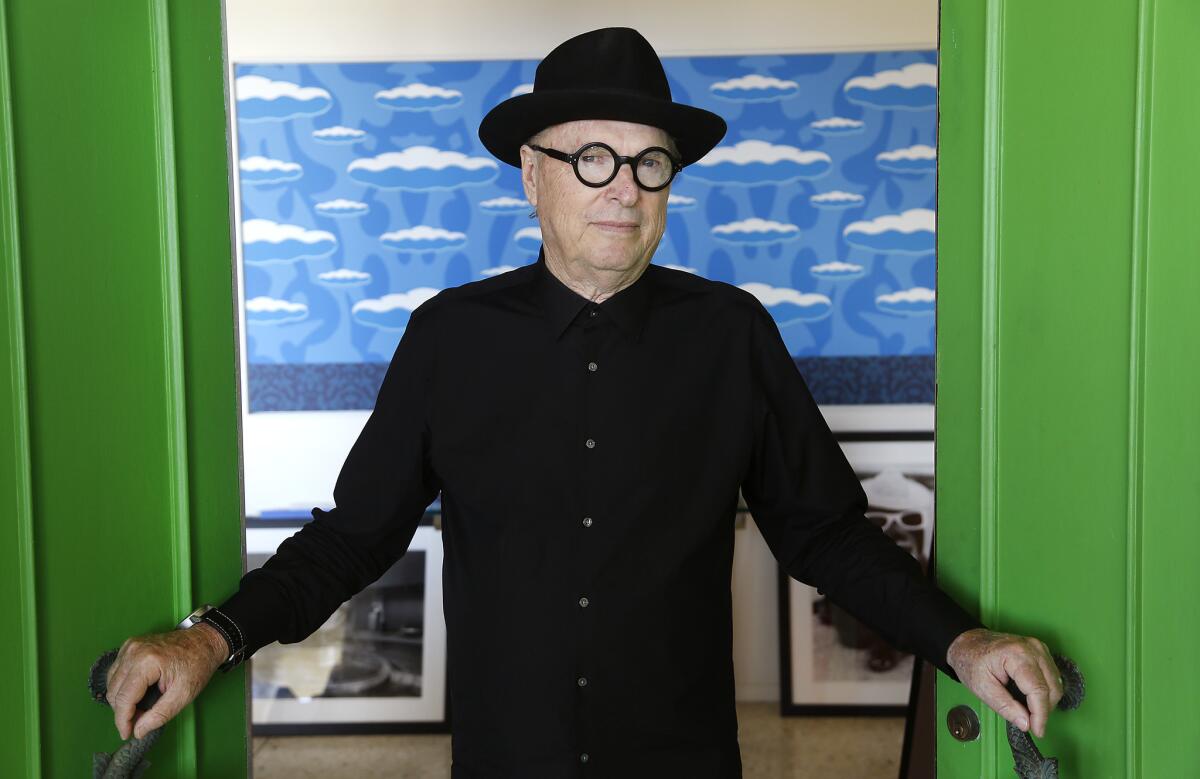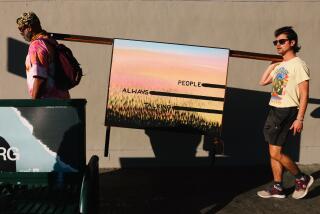An ‘Endless Summer’ for artist John Van Hamersveld

John Van Hamersveld designed the famous album jacket for the Rolling Stones’ “Exile on Main St.” Forty-two years later, he’s embedded on Main Street.
Main Street in Huntington Beach, that is.
Last month, the Southern California graphic artist was inducted into the Surfing Walk of Fame. His name is now engraved in granite along a sidewalk that honors some 140 figures who’ve shaped surfing by riding the waves, contributing to fashion and surfboard technology or by chronicling the sport in music, film, photography, journalism and art.
------------
FOR THE RECORD:
John Van Hamersveld: An article about graphic artist John Van Hamersveld in the Aug. 17 Arts & Books section said that he and his wife have bought the former Williams’ Bookstore in San Pedro. They are renting the space. —
------------
The surfing walk is on the northern side of Main in the block closest to the ocean and the Huntington Beach Pier. Van Hamersveld, 72, is the second visual artist (other than photographers and filmmakers) to join Surf City’s version of the Hollywood Walk of Fame. The other is the late Rick Griffin, a close friend of Van Hamersveld’s who followed a parallel path as an artist immersed in surf culture and rock music.
“It was a wonderful ceremony,” Van Hamersveld said afterward. He had marked the occasion by unveiling a new poster of one of his fellow 2014 inductees, Larry Bertlemann, a Hawaiian surfing champion known for his acrobatic style.
Van Hamersveld’s bushy-haired image of the surfer drew on one of his most famous rock music graphics, a poster of Jimi Hendrix that advertised a 1968 concert by the guitar hero at the Shrine Auditorium, part of a series of shows promoted by Pinnacle Happenings, a short-lived company that Van Hamersveld ran.
Shepard Fairey paid Van Hamersveld the ultimate tribute 20 years ago by swiping his Hendrix image and replacing it with Fairey’s own calling card, a graphic evocation of wrestler Andre the Giant. Fairey has called Van Hamersveld’s original poster “a perfect image” and “my favorite poster of all time ... an epiphany that sharpened my focus as an artist.”
But perhaps even more perfect is the poster Van Hamersveld created almost 50 years ago for the film “The Endless Summer.” It’s probably the biggest reason he’s in the Walk of Fame, an honor conferred by some 200 surfing insiders from around the world.
In tandem with Bruce Brown’s film, Van Hamersveld’s rendering of three surfers carrying their boards on a beach while silhouetted against a brilliant sun on the horizon helped Southern California surf culture surge to global consciousness.
Forty years later, Los Angeles Times art critic Christopher Knight wrote about the mood Van Hamersveld’s creation continued to summon: “free-spirited beach bums in an otherworldly terrain engorged with pure psychedelic beauty. ... The image was the stuff of epic literature, high or low. ... The sun, poised between perpetual rising and continuous setting, forged an eternal radiance.”
Van Hamersveld had fully immersed himself in the surf scene by the time he created that image. Phil Becker, a friend he’d grown up with in Palos Verdes, was a surfboard shaper and merchant, and in the early 1960s, the budding artist, who also loved to surf, would accompany Becker on his rounds of surf shops up and down the coast.
Inspired by his mother, who was an artist, Van Hamersveld enrolled at the Art Center College of Design at 19 and soon began using his growing skills as art director for Surfer Magazine.
Van Hamersveld said his training at the Art Center, then in downtown L.A. and now in Pasadena, gave him crucial preparation for hatching the “Endless Summer” poster design.
“The beauty of the school was it practiced in a Bauhaus way. Modernism was being taught, the contemporary world,” he said. “The poster engages that modernism in the color blocks and the geometric shapes, and adding Day-Glo color made it into pop art.”
Curators agreed when they included his poster in the Los Angeles County Museum of Art’s well-received 2011-12 exhibition “California Design, 1930-1965: Living in a Modern Way.” The poster is in the collections of both LACMA and New York’s Museum of Modern Art. The artist said he took special satisfaction from how the LACMA show used his signature work.
“After you went by Charles and Ray Eames’ [furnishings] and all these other things, at the end of the show you came to my ‘Endless Summer’ poster,” he said. “You were leaving the old world and moving into the new world of pop art” that ensued after the period chronicled by the exhibition. “It was very well done.”
Instead of resting on his “Endless Summer” laurels, Van Hamersveld in 1965 enrolled in the Chouinard Art Institute, which later morphed into the California Institute of the Arts.
He then embarked on his rock music phase, promoting his own shows by night and working at a day job as artistic director for Capitol Records’ distribution wing. In that capacity, he designed the American cover for the Beatles’ “Magical Mystery Tour” album, adapting a core image from the previously released British double-EP package into a more artfully balanced and richly psychedelic display.
Van Hamersveld didn’t meet the Beatles for that assignment, but he worked directly with Mick Jagger and a sometimes zonked-out Keith Richards in L.A. to create the “Exile on Main St.” package.
Photographer Norman Seeff took pictures of the band that wound up in an inside accordion fold-out of Stones postcards — an idea contributed by Richards — while Van Hamersveld drew heavily on the work of photographer Robert Frank for the rest of the package. At the time, Frank was trailing the Stones while directing a salaciously named, ill-fated film documentary of their 1972 tour. It rarely has been screened because of a dispute between Frank and the band.
For the “Exile” cover, Van Hamersveld cropped Frank’s earlier photograph of a collage of circus freaks, which Frank had found decorating the wall of a tattoo parlor. He says the “Main St.” in the title is in fact Main Street in Los Angeles, because Frank took the Stones there for a photo session for the album jacket. The “Exile” part referred to the band’s self-exile to France to avoid heavy taxation in England.
Among Van Hamersveld’s other album art credits are Jefferson Airplane’s “Crown of Creation,” Kiss’ “Hotter Than Hell,” the Grateful Dead’s “Skeletons in the Closet,” Blondie’s “Eat to the Beat” and Public Image Ltd.’s “This is What You Want ... This is What You Get.”
The artist said the PiL album cover, sporting vivid lettering emblazoned on a photograph of a psychotically glaring John Lydon, was his last for 30 years — until now.
On Aug. 12, the New Jersey band the Gaslight Anthem released the album “Get Hurt,” which sports a Van Hamersveld cover dominated by a big, red upside-down heart. The artist said the band’s manager hired him after seeing an article in Vanity Fair magazine about Van Hamersveld and the 50th anniversary of his poster for “The Endless Summer.”
Van Hamersveld’s other recent activities include a 2010 autobiography, “John Van Hamersveld: My Art, My Life,” which takes his story from childhood to 1975, and a 2013 art book, “John Van Hamersveld: 50 Years of Graphic Design.”
Long vanished is the 360-foot-long stylized mural of athletes he created on individual vinyl panels outside the Los Angeles Coliseum for the 1984 Summer Olympics.
“The Olympic Committee didn’t understand the value of it,” said Van Hamersveld, who has remained anchored in Southern California and again lives in Palos Verdes after a period in Malibu. “They auctioned [each panel] off for like $250. It was a tragedy.”
Van Hamersveld said that he and his wife, art dealer Alida Post, have bought Williams’ Bookstore on 6th Street in San Pedro, which closed last year after being in business for 104 years. They are turning it into a gallery scheduled to open this month, showing Van Hamersveld’s work, among others, and housing an art studio for him to use.
Van Hamersveld said the Surfing Walk of Fame marker is one of the few honors he’s had from institutions; another came when former Art Center President Richard Koshalek conferred a degree on him even though he hadn’t accumulated enough credits in the 1960s.
Van Hamersveld is eager now for more assignments that will keep what he calls “that left hand and eye” working hard.
With age, he said: “Your perceptions get better, and all that unconscious memory and experience, you just have to exploit it.”
Twitter: @boehmm
More to Read
The biggest entertainment stories
Get our big stories about Hollywood, film, television, music, arts, culture and more right in your inbox as soon as they publish.
You may occasionally receive promotional content from the Los Angeles Times.







